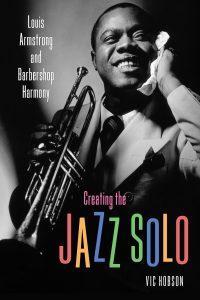 As if the origins of Jazz weren’t already mired in countless controversial theories and myth (founded and unfounded, scholarly or otherwise), along comes Vic Hobson’s, new book, Creating the Jazz Solo: Louis Armstrong & Barbershop Harmony, with yet another radical, but beautifully argued new position on the subject.
As if the origins of Jazz weren’t already mired in countless controversial theories and myth (founded and unfounded, scholarly or otherwise), along comes Vic Hobson’s, new book, Creating the Jazz Solo: Louis Armstrong & Barbershop Harmony, with yet another radical, but beautifully argued new position on the subject.
According to musicology Ph.D., Hobson, it was barbershop quartet singing and its “ear” arranging methods that specifically gave rise and form to Louis Armstrong’s trumpet playing, and ultimately shaped his solos, which, by extension, influenced all of Jazz (from Armstrong’s position as a seminal pioneer and trendsetter of early Jazz).
Meticulously and systematically calling on civil, school, church, and newspaper records, eyewitness oral histories, and a great many of Satchmo’s own accounts (spoken, televised, written or performed—including those slightly dubious and not) Hobson vividly lays out (without pretense of scholarly authority) the earliest, and less explored years of Armstrong’s vocal and musical development prior to 1920.
Hobson’s premise aside, the book is engaging and worthwhile reading filling in the details of Louis’ earliest musical years—particularly those before and during his days detained at the Waif’s Home- before he began playing trumpet. While a technical understanding of music theory adds value and support to Hobson’s thesis (the better part of the last quarter of the book’s discussion of specific song analysis depends on it) his non-musical illustrations, dramatic vignettes, and his concise, poignant narratives and quotes, credibly frame his points otherwise, and make for thoughtful historic reading.
Far above all else—and almost a radical position itself—Hobson builds his case on the primacy of singing and harmonizing in Louis Armstrong’s childhood. He calls on an array of sources testifying to the scope of the musical environment and the cultural influences (speculative and documented) surrounding Louis’ boyhood and his activities. Hobson quotes many of Armstrong’s consistent recollections to establish that ”Singing was more into my blood than the trumpet”; “I figure singing and playing is the same” and that Church is where “I acquired my singing tactics.”
It is however Armstrong’s youthful quartetting (roughly 1912-1915), as the quartet’s harmonizing high 1st tenor, that Hobson argues, Louis learned, and internalized his visceral understanding of the harmonic progressions and the distinct functions of the four voice parts—as they were understood and popularly practiced in Barbershop singing in his day and which was itself, as Hobson carefully parses, uniquely and identifiably derived largely from Afro-Americanized origins.
These practices, Hobson goes on to show, formed the foundations upon which Armstrong built his trumpet playing. It led him to abstract from the arpeggiated chords of barbershop, the ideas that evolved into solo “routines” closely playing harmonically around the leading 2nd tenor’s melody line, capitalizing on barbershop’s uniquely idiosyncratic propensity for dominant 7th chords, “funnel tonality,” and leading progressions that create tension and release, created by moving around the circle of 5ths.
Throughout the book Hobson constructs his argument with ample musical illustrations and loose analysis calling upon rare original sheet music and period books. It was with particular joy for me to finally see the song “Down On The Amazon” mentioned by Armstrong (as “My Brazilian Beauty”) as one in his quartet’s repertory, but practically unknown today.
Similarly he draws parallels between Armstrong’s solos and, for example, criteria found in music critic, Sigmund Spaeth’s 1925 informal book, Barbershop Ballads: A Book of Close Harmony following his “rules of Barbershop.”
Full disclosure: I was a member of the Barbershop Harmony Society and a quartetter for many years. I’ll admit to being less than musically literate and receptive to Hobson’s thesis. It is also a treat to see that Hobson (apparently not a singer or a Barbershop Society member himself) consulted many of the Barbershop Society’s most literate, published members, and that his research includes the writings of notable musicologists on barbershop such as Gage Averill, Lynne Abbott, and James Henry. That said, Hobson’s coverage is comprehensive, cogent, articulate, colorful, and independent of the bias and agenda I proudly share with my fellow barbershoppers.
The book is an enjoyable gem of independent thought and it’s thoroughly researched. Anyone interested in Armstrong, especially his early life, his singing or the evolution of the solo will be well served to read it. It has excellent footnoted source references and its main text, at 173 pages is a fast, easy read, too.
Creating the Jazz Solo: Louis Armstrong & Barbershop Harmony by Vic Hobson, University Press of Mississippi; 288 pages; $30.00 (paper); ISBN 13: 9781496819772 www.upress.state.ms.us






















